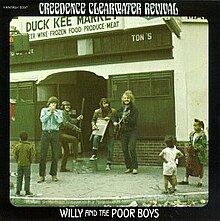
Creedence Clearwater Revival, commonly abbreviated as CCR or simply Creedence, was an American rock band formed in El Cerrito, California. The band consisted of lead vocalist, lead guitarist, and primary songwriter John Fogerty, his brother, rhythm guitarist Tom Fogerty, bassist Stu Cook, and drummer Doug Clifford. These members had played together since 1959, first as the Blue Velvets and later as the Golliwogs, before settling on Creedence Clearwater Revival in 1967. The band's most prolific and successful period between 1969 and 1971 produced fourteen consecutive Top 10 singles and five consecutive Top 10 albums in the United States – two of which, Green River (1969) and Cosmo's Factory (1970), reached number one. The band performed at the 1969 Woodstock festival in Upstate New York, and was the first major act signed to appear there.

John Cameron Fogerty is an American singer, songwriter and guitarist. Together with Doug Clifford, Stu Cook, and his brother Tom Fogerty, he founded the swamp rock band Creedence Clearwater Revival (CCR), for which he was the lead singer, lead guitarist, and principal songwriter. CCR had nine top-10 singles and eight gold albums between 1968 and 1972, and was inducted into the Rock and Roll Hall of Fame in 1993.

Cosmo's Factory is the fifth studio album by American rock band Creedence Clearwater Revival, released by Fantasy Records on July 8, 1970. Six of the album's eleven tracks were released as singles in 1970, and all of them charted in the top 5 of the Billboard Hot 100. The album spent nine consecutive weeks in the number one position on the Billboard 200 chart and was certified 4x platinum by the Recording Industry Association of America (RIAA) in 1990. Rolling Stone ranked it number 413 on its 2020 list of the "500 Greatest Albums of All Time".

Creedence Clearwater Revival is the debut studio album by American rock band Creedence Clearwater Revival, released in July 1968, by Fantasy Records in the US. Featuring the band's first hit single, "Susie Q", which reached number 11 in the US charts, it was recorded shortly after the band changed its name from the Golliwogs and began developing a signature swamp rock sound.
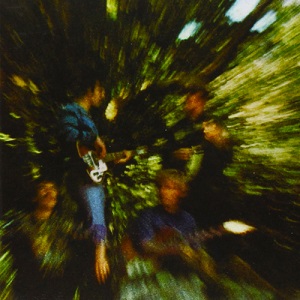
Bayou Country is the second studio album by American rock band Creedence Clearwater Revival, released by Fantasy Records on January 15, 1969, and was the first of three albums CCR released in that year. Bayou Country reached number 7 on the Billboard 200 chart and produced the band's first No. 2 hit single, "Proud Mary".
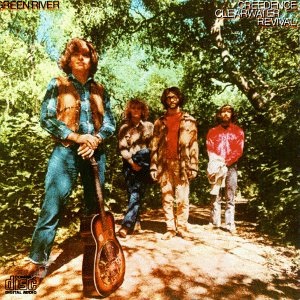
Green River is the third studio album by American rock band Creedence Clearwater Revival, released on August 7, 1969 by Fantasy Records. It was the second of three albums they released in that year, preceded by Bayou Country in January and followed by Willy and the Poor Boys in November.

Mardi Gras is the seventh and final studio album by American rock band Creedence Clearwater Revival, released on April 11, 1972 by Fantasy Records. Recorded after the departure of guitarist Tom Fogerty, it was the band's only studio album as a trio, and featured songs written, sung, and produced by each of the remaining members, rather than just John Fogerty. The recording sessions were marred by personal and creative tensions, and the group disbanded after a short U.S. tour to support the album.

Live in Europe is the first live album by American rock band Creedence Clearwater Revival. Although released in 1973, it was recorded in 1971 during the Pendulum tour.
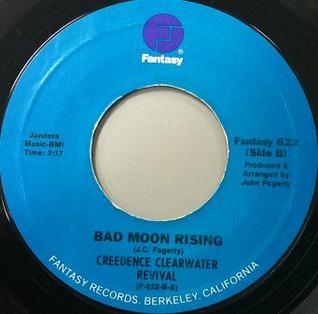
"Bad Moon Rising" is a song written by John Fogerty and performed by Creedence Clearwater Revival. It was the lead single from their album Green River and was released on April 16, 1969 four months before the album. The song peaked at No. 2 on the Billboard Hot 100 chart on 28 June 1969 and reached No. 1 on the UK Singles Chart for three weeks in September of that year. It was CCR's second gold single.

"Proud Mary" is a song by American rock band Creedence Clearwater Revival, written by vocalist and lead guitarist John Fogerty. It was released as a single in January 1969 by Fantasy Records and on the band's second studio album, Bayou Country. The song became a major hit in the United States, peaking at No. 2 on the Billboard Hot 100 in March 1969, the first of five singles to peak at No. 2 for the group.
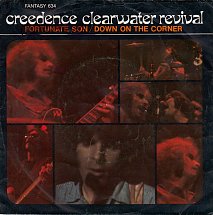
"Fortunate Son" is a song by the American rock band Creedence Clearwater Revival, released on the band's fourth studio album, Willy and the Poor Boys in October 1969. It was previously released as a single, together with "Down on the Corner", in September 1969. It soon became a Vietnam anti-war movement anthem and an expressive symbol of the counterculture's opposition to U.S. military involvement in the Vietnam War and solidarity with the soldiers fighting it. The song has been featured extensively in pop culture depictions of the Vietnam War and the anti-war movement.

Chronicle, or fully Chronicle: The 20 Greatest Hits, is a greatest hits album by the American rock band Creedence Clearwater Revival. It was released in January 1976 by Fantasy Records. The edited version of "I Heard It Through the Grapevine" featured on the album was simultaneously released as a single.
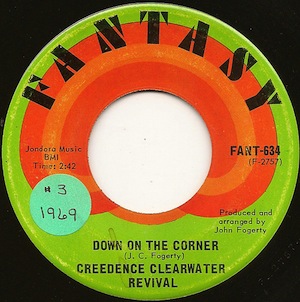
"Down on the Corner" is a song by the American band Creedence Clearwater Revival. It appeared on their fourth studio album, Willy and the Poor Boys (1969). The song peaked at No. 3 on the Billboard Hot 100 on 20 December 1969. The flip side, "Fortunate Son", reached No. 14 on the United States charts on 22 November 1969, the week before Billboard changed its methodology on double-sided hits.
"Susie Q" is a rockabilly song co-written and performed by American musician Dale Hawkins released in 1957. The song was a commercial success, and became a classic of the early rock and roll era being recorded by many other performers in subsequent years.
"Who'll Stop the Rain" is a song written by John Fogerty and originally recorded by Creedence Clearwater Revival for their 1970 album Cosmo's Factory. Backed with "Travelin' Band", it was one of three double-sided singles from that album to reach the top five on the Billboard Pop Singles chart and the first of two to reach the No. 2 spot on the American charts, alongside "Lookin' Out My Back Door"/"Long As I Can See the Light". In 2004, Rolling Stone ranked it No. 188 on its "500 Greatest Songs of All Time" list.

"Green River" is a song by American rock band Creedence Clearwater Revival. It was written by John Fogerty and released as a single in July 1969, one month before the album of the same name was released. "Green River" peaked at number two for one week, behind "Sugar, Sugar" by The Archies, and was ranked by Billboard as the No. 31 song of 1969.
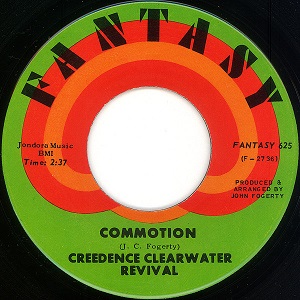
"Commotion" is a song by Creedence Clearwater Revival from the album Green River, and was also the B-side of the single release of the album's title track. In 1980, "Tombstone Shadow" b/w "Commotion'" was released as a single in the United States. While released as a B-side, "Commotion" reached #30 in the United States on the Billboard Hot 100 and #16 in Germany. It was written by John Fogerty and recorded at Wally Heider's Studios in San Francisco in June 1969. The 45rpm was the debut session of the band at Wally Heider's and the first collaboration with engineer Russ Gary.

"It Came Out of the Sky" is a song written by John Fogerty that was included on Creedence Clearwater Revival's 1969 album Willy and the Poor Boys. It was also released as a single in some countries and has appeared on several of the group's compilation albums. It was included occasionally in the group's live set even after John Fogerty left the group and the remaining members reformed as Creedence Clearwater Revisited.
"Don't Look Now " is a song written by John Fogerty that was first released on Creedence Clearwater Revival's 1969 album Willy and the Poor Boys. It has also appeared on several of the group's live and compilation albums. It was covered by Minutemen on their 1984 album Double Nickels on the Dime.

Ultimate Creedence Clearwater Revival: Greatest Hits & All-Time Classics is a three-disc greatest hits album by the American roots rock band Creedence Clearwater Revival, released in 2012 by Fantasy Records and Concord Music Group.
